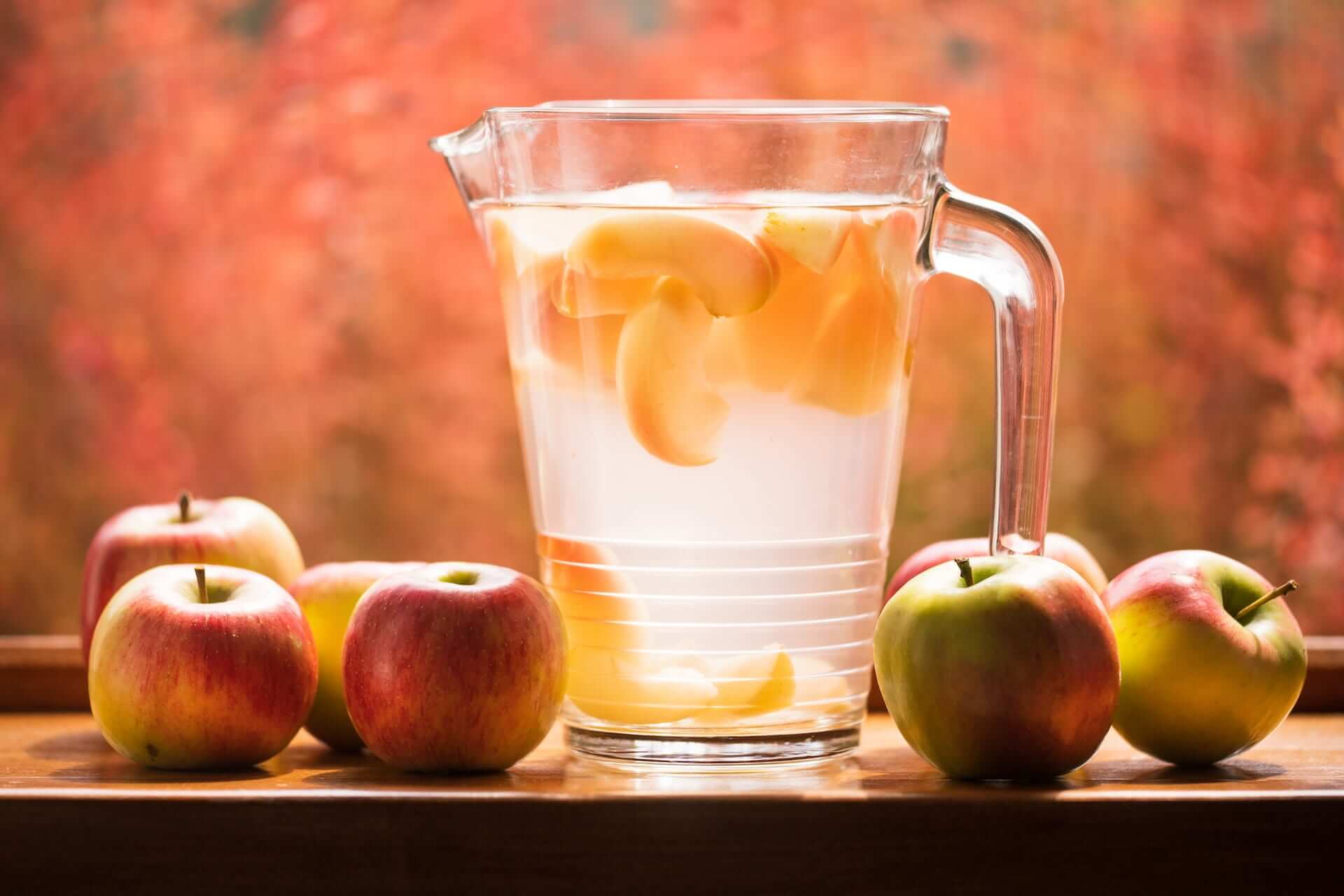Unsurprisingly, the apple is one of the most commonly consumed fruits worldwide. It’s delicious, nutritious, and highly versatile. Whether you eat it whole, mix slices into a refreshing salad, or add chunks to your favorite sweet or savory recipes, an apple can add flavor and a wide range of nutrients to your day.
While an apple a day may not keep the doctor away, it can certainly positively impact our health. But is apple juice good for you? Apple juice can offer the same or similar health benefits as a whole apple, but of course, it’s important to follow some precautions when drinking sugary beverages. In this article, we’ll look at the ins and outs of apple juice, including how it’s made, potential pros and cons, and how to include it in a healthy diet.
Apple Juice Nutrition Facts and Glycemic Index
Apple juice is made by pressing apples of all kinds. It takes approximately two medium-sized fruits to make one cup of juice, so apples are typically grown in large quantities.
After the apples are pressed, the resulting juice often goes through further filtering or pasteurization to remove particulate matter. The remaining thin consistency is ideal for a refreshing glass of apple juice. The fruit juice may also be sweetened with added sugar, depending on the formula.
The nutritional value of apple juice differs from that of a fresh apple. However, it can retain many of the same vital nutrients. Apple juice contains vitamins C and B and minerals like copper, magnesium, iron, manganese, and potassium.
A cup of juice has significantly less fiber than whole fruit, but some fiber is retained along with flavonols and phytochemicals.
According to the USDA food database, one cup of 100 percent apple juice provides 119 calories and 28 grams of carbohydrates.1 This translates to approximately 10 percent of your daily carbohydrate requirement if following a 2,000-calorie diet.
If we’re talking glycemic index, apple juice can be classified by varying numbers depending on added sugars. However, unsweetened apple juice has a glycemic index of 41.2 While that’s considered a low glycemic beverage, we still need to be mindful of its impact on our blood sugars.
{{mid-cta}}
8 Possible Health Benefits Apple Juice
While eating the whole fruit ensures you get all its unprocessed nutrients, drinking apple juice also offers potential health benefits. The health benefits of apple juice can include:
Hydration Support
Apple juice comprises mainly water— 88 percent water by weight, to be exact. And it tastes delicious, making it more enjoyable and easier to consume, especially when you’re sick and at risk for dehydration.
Pediatricians even recommend diluted apple juice to help prevent or treat dehydration in children. A 2016 study published in the Journal of American Medical Association showed that half-strength apple juice, diluted with water, can be an effective alternative to electrolyte management in children with minimal dehydration.3 The same can be true for adults too.
Beneficial Plant Compounds
Apples are packed with nutrition. While many of the nutritious plant compounds are found in the peel, some are retained in the juice from the apple’s flesh. These compounds may protect your cells from inflammation and damage from oxidative stress, both of which can contribute to chronic disease.
Want more polyphenols? Look for cloudy apple juice as it contains pulp, thus having more polyphenols.
Heart Health Support
Some plant compounds in apple juice, like polyphenols, may benefit our heart health. For example, polyphenols can help prevent LDL cholesterol from oxidizing and building up in our arteries, often linked to an increased risk of heart attack and heart disease.4 Because apples contain potassium, a vasodilator, it’s understood that apple juice may help lower blood pressure by relieving stress on blood vessels.
Brain Health Support
Oxidative stress can impact neurodegenerative diseases, such as Parkinson's and Alzheimer’s disease. This is because oxidative stress can induce neuronal damage, ultimately leading to neuronal death by necrosis. Like those found in apples and other fresh fruits and vegetables, polyphenol antioxidants can help treat neurodegenerative diseases by acting as scavengers for free radicals.
Skin Health Support
Vitamin C plays a significant role in skin health, helping to heal wounds and clot blood properly. It’s essential for skin regeneration and repair. Apples are a good source of powerful vitamins, and many apple juices are fortified to meet 100 percent of our daily needs in just one serving.

Anti-Cancer Potential
Apples are rich in polyphenols and phytochemicals, which have strong antioxidant properties. Apples also contain phytochemicals like quercetin, catechin, phloridzin, and chlorogenic acid. The antioxidants track down free radicals and neutralize their harmful effects, many of which contribute to cancer.
The phytochemical composition can vary significantly between apple varieties and may be affected during processing. While apple juice typically contains fewer phenolics than whole apples, it’s still a widely consumed source of dietary antioxidants.5
Constipation Relief
When combined with water and other nutrients, apple juice may help relieve constipation. Apples contain malic acid, which can aid digestion and support liver function.
Eye Health Support
Vitamin A is a major proponent of eye health and plays a major role in our vision. The vitamin A in apples can help sharpen vision and prevent future eye disorders. While it doesn’t contain as much as whole apples, apple juice contains small amounts of this specific vitamin.
5 Potential Downsides of Apple Juice
Alas, it’s not all sunshine and rainbows when it comes to drinking apple juice. There are a few downsides and potential side effects in certain situations.
May Contribute to Weight Gain
For adults, the serving size is one cup of apple juice, but most people drink more than that. Juice can be consumed much faster than a whole apple, making it easy to take in many calories quickly. Since apple juice lacks fiber, it does not contribute to feelings of fullness like a whole piece of fruit does. Eating whole fruit may be more beneficial if your health goals include weight loss.
May Cause Gastrointestinal Problems
The high-sugar content of full-strength apple juice can draw excess water into your gut and cause diarrhea. So, if you are rehydrating with apple juice, be sure to dilute it with water.
Encourages Tooth Decay
Sugary beverages, like fruit juice, have been linked to tooth decay. This is because the bacteria in our mouths consume the sugar from the juice, producing acids that can cause erosion on the tooth’s surface. The longer the sugar sits on teeth, the longer the bacteria can act on it.
May Spike Blood Sugar Levels
No matter your medical history, try to choose 100 percent juice varieties, as they have less effect on blood sugar levels than juices with added sugar.
Still, almost all the calories in 100 percent apple juice come from carbohydrates, specifically naturally occurring fructose and glucose. Yet, a one-cup serving of juice provides less than one gram of fiber. Unfortunately, this is an equation for rollercoaster blood sugar levels, meaning your blood sugar will spike quickly after consumption and drop almost as quickly.
Low in Vitamins and Minerals
Even though that glass of apple juice is packed with flavor, it lacks nutrition. The recommended one-cup serving falls significantly short of the Reference Daily Intake for any micronutrient.
Some brands fortify their apple juice with vitamin C or ascorbic acid to meet 100 percent of your daily needs. But, of course, you can always eat various fruits and vegetables to meet your daily quota for vitamin C and other nutrients.
What is the Best Type of Apple Juice to Drink?
There are many different types of apple juice, but 100 percent apple juice may be the ideal choice for most people. Of course, there are a few other factors to consider as well.
Organic apple juice may have less pesticide exposure and preservatives, but the most important factor is the apple juice’s sugar content. While 100 percent apple juice will not have added sugar, other types will. The more concentrated a juice is with sugar and calories, the more it can contribute to weight gain and elevated glucose levels.
Eating a fresh apple may be more appropriate than drinking a glass of juice if you’re sensitive to sugar content or have a history of uncontrolled blood sugar levels.
Not sure where to start your search for the best apple juice? Consider these brands:
- North Coast Organic Apple Juice- North Coast takes pride in what’s included in its juice. The ingredient list is simple— 100 percent organic apples. North Coast uses U.S.-grown apples that are pressed and bottled on arrival.
- Lakewood Organic Pure Apple Juice- Lakewood apple juice is made with organic apples, free from additives, preservatives, pesticides, colorants, and allergens. It has a cloudy appearance since much of the pulp isn’t strained during production, keeping much of its flavor and nutrients intact.
- Tree Top- Tree Top makes its apple juice using unique varieties such as honeycrisp or cosmic apples. Unlike many of the apple juice brands on the market today, Tree Top customers can enjoy a variety of sweet and tart flavors.
FAQs about Apple Juice
How often should you drink apple juice?
We all have individualized nutrition needs, but apple juice can be part of a daily diet if consumed in proper amounts. However, we must be mindful of our overall carbohydrate intake and ensure we get enough fiber daily.
What's the difference between cloudy and clear apple juice?
The obvious difference between clear and cloudy apple juice is the difference in appearance. Cloudy juice contains apple solids, whereas clear juice does not. However, another significant difference is their antioxidant properties. When clear apple juice is produced, an enzyme strips the juice of its natural antioxidants. Cloudy juice, however, does not use this enzyme, so it typically has more of an antioxidant punch.
Apple juice vs. orange juice; which one is better?
Both apple juice and orange juice offer their own health benefits, so the answer to that question may vary depending on who you ask. Orange juice contains more vitamin C and potassium than apple juice, but apple juice typically contains more carbohydrates. You may choose one or the other depending on your needs.

Learn More About Nutrition and Healthy Eating with Signos’ Expert Advice.
Signos CGM helps you embrace and improve your health by keeping track of your diet, physical activity, and blood sugar levels. Continuous glucose monitoring gives you real-time data that you can use to adjust your lifestyle habits in pursuit of the healthiest you. And if you have questions about your nutrition needs, consider meeting with a registered dietitian nutritionist!
Find out if Signos is a good fit by taking a quick quiz!
- Item 1
- Item 2
- item 3
Topics discussed in this article:
References
- USDA. (n.d.). 100% Apple Juice. FoodData Central. Retrieved March 12, 2023, from https://fdc.nal.usda.gov/fdc-app.html#/food-details/2344814/nutrients
- The University of Sydney. (n.d.). GI Search- Apple Juice. Glycemic Index. Retrieved March 12, 2023, from https://glycemicindex.com/gi-search/?food_name=apple%2Bjuice&product_category=&country=&gi=&gi_filter=&serving_size_%28g%29=&serving_size_%28g%29_filter=&carbs_per_serve_%28g%29=&carbs_per_serve_%28g%29_filter=&gl=&gl_filter=
- Freedman, S. B., Willan, A. R., Boutis, K., & Schuh, S. (2016). Effect of Dilute Apple Juice and Preferred Fluids vs Electrolyte Maintenance Solution on Treatment Failure Among Children With Mild Gastroenteritis: A Randomized Clinical Trial. JAMA, 315(18), 1966–1974. https://doi.org/10.1001/jama.2016.5352
- Gao, S., Zhao, D., Wang, M., Zhao, F., Han, X., Qi, Y., & Liu, J. (2017). Association Between Circulating Oxidized LDL and Atherosclerotic Cardiovascular Disease: A Meta-analysis of Observational Studies. The Canadian journal of cardiology, 33(12), 1624–1632. https://doi.org/10.1016/j.cjca.2017.07.015
- Boyer, J., & Liu, R. H. (2003). Apple phytochemicals and their health benefits. Nutrition Journal, 3, 5. https://doi.org/10.1186/1475-2891-3-5












.jpg)



















